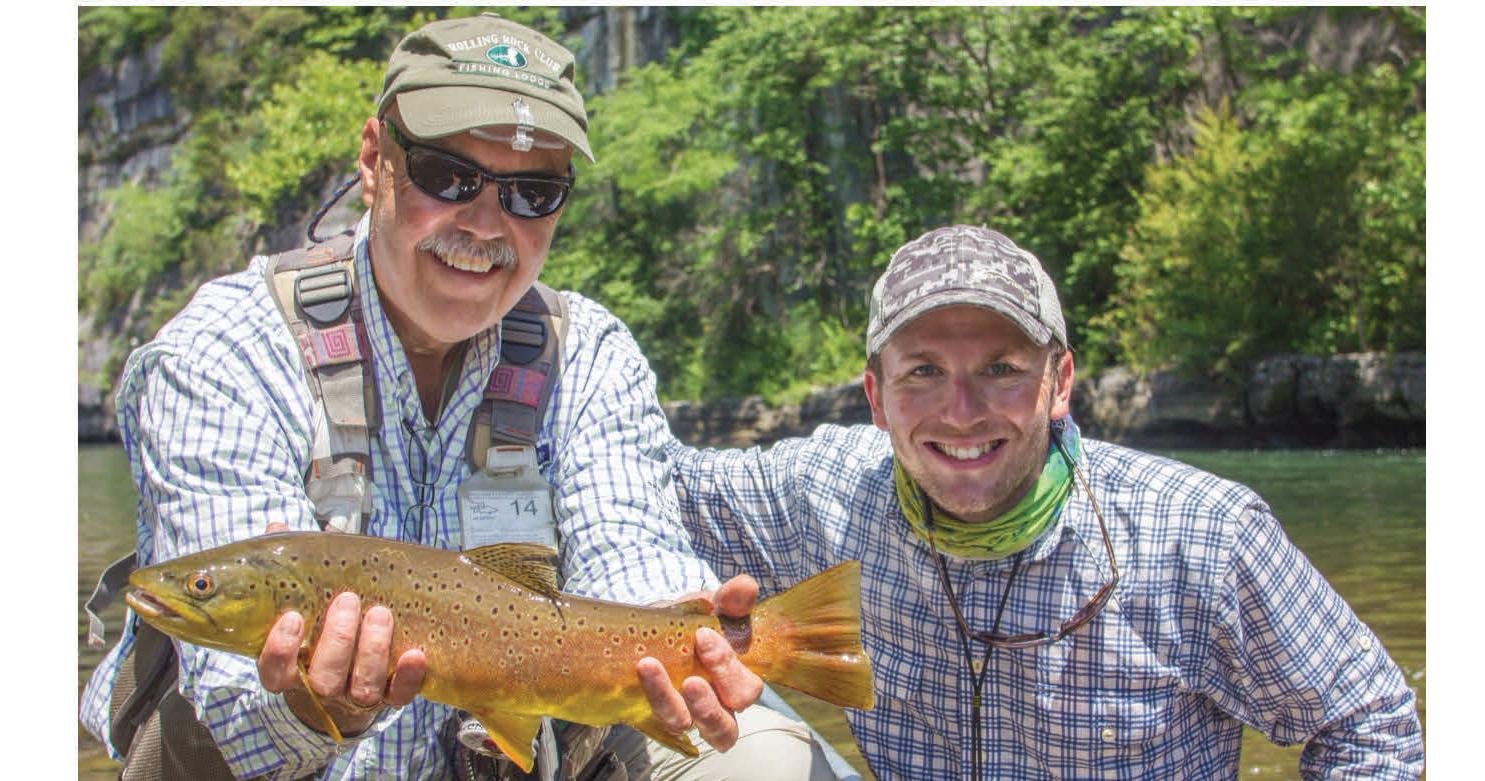




































































PUBLISH YOUR OWN FISHING MAGAZINE!
If you love the outdoors and dream of being in business for yourself, now is the time to choose a Coastal Angler or e Angler Magazine Franchise.
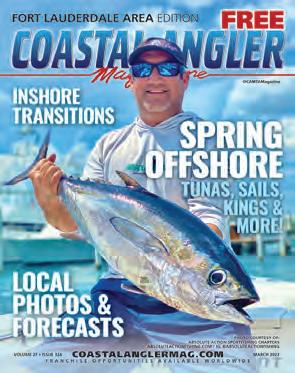
Established Brand • Proven Systems Training & Ongoing Support

Work From Home • Be Your Own Boss
• Alabama - SOLD
• Big Bend, FL
• Charlotte, NC
• Connecticut/Rhode Island
• Daytona Beach, FL - SOLD
• Destin/Pensacola, FL - SOLD
• Eastern Tennessee
• Georgia (Coastline, Savannah)
• Lake Erie, Ohio - SOLD
• Lake Michigan
• Long Island, NY
• Miami, FL - SOLD!
• New Hampshire
• New Jersey
• New Orleans, LA
• North Carolina (Raleigh, Wilmington)
• Okeechobee, FL - SOLD
• Outer Banks, VA
• Panama City, FL - SOLD!
• South Carolina (Hilton Head, Myrtle Beach)
• Tallahassee, FL/SW GA
• Texas (Coastal, Houston)
• ...YOUR HOMETOWN!
Don’t see your location? Ask one of our specialists about franchise availability in your area.
1-888-800-9794
info@coastalanglermagazine.com
franchise.coastalanglermag.com
Dear Angler,

We’re looking to expand our franchise footprint and are seeking like-minded outdoor enthusiasts who share in our vision to bring our free publication to every town in America! is is a great opportunity to own your own business, control your time and, to a great extent, control your income.
Our Ideal Franchise Candidate Will:
• Be an avid angler and/or love the outdoors.
• Have either prior business experience or a minimum of three years sales experience.
• Good communication skills
• Good credit
If you or someone you know is looking for an opportunity to own their own home-based business and earn a living in the outdoor industry, please contact us toll-free at 1.888.800.9794 or email info@coastalanglermagazine.com.
Tight lines, Ben Martin Editor In Chief Coastal Angler Magazine e Angler Magazine
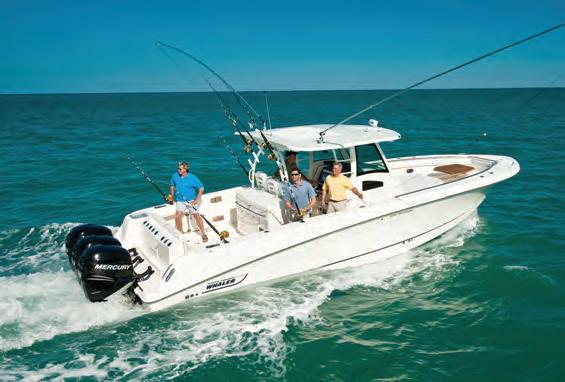

www.CoastalAnglerMag.com
FRANCHISOR-CORPORATE DIRECTORY
EDITOR IN CHIEF : Ben Martin • camads@coastalanglermagazine.com
COO : Tracy Patterson • tracy@coastalanglermagazine.com
ART DIRECTOR : Laura Kelly • graphics@coastalanglermagazine.com
EDITORIAL COORDINATOR : Nick Carter • editorial@coastalanglermagazine.com
WEBMASTER : Ryan Clapper • webmaster@coastalanglermagazine.com
ADVERTISING & FRANCHISE INQUIRIES: info@coastalanglermagazine.com • 888.800.9794
FRANCHISE DIRECTORY LINK
www.coastalanglermag.com/directory



Sfrequent, and the pelagics are plentiful. is time of year, you can usually point your boat o shore and eventually run into the mecca. However, these sought-a er pelagic species are moving around through their migrations and nding them isn’t always guaranteed. Sometimes you just get unlucky running and gunning all day, on the hunt for birds, debris and weed lines. Whether you are out there with no signs of life or just can’t seem to get away from schools of undersized sh, it’s a good idea to have a backup plan to save the day and make the fuel bill worth it.
Having a deep-drop rig ready to go can save a day of o shore shing. Sword shing can be an epic day saver, but it takes quite a bit of time, gear and involvement to have a good chance. ere are a lot of opportunities for shing the bottom between the reef and the sword grounds.
With a set-up that can handle shing between 500 and 1,000 feet, you will have what you need to quickly pepper in some drops during your day, without spending too much time setting it up and packing it away. ere are a variety of edible aliens that can be targeted, or even snagged as bycatch, when shing in the deep, but pretty much all
onboard, in case you get hung on the bottom, or adjustments need to be made due to the current. Having the right weight is important, and it is pretty easy to tell a er a drop if you have put on too much or too little. I would recommend having 6-, 8- and 10-pound weights to make your adjustments with. ese leads can be extremely pricey, so look into some DIY methods if this is something you plan to get into.
Depending on what you want to target, there are a few variations you will want for your rigs. Utilizing 300-pound mono and sleeve swivels, space out up to ve hooks along the leader, making the drop-down leaders short enough that they won’t tangle with each other. Play around with di erent size hooks and spacing between them. If you aren’t sure what might be living on a newfound bottom spot, drop a rig with varied hook sizes, having the biggest on the bottom. It is also a good idea to a x a 6-inch, 50-pound breakaway leader to the lead to save the rest of your gear when you inevitably get hung up.

Searching for new bottom spots can be one of the most exciting parts about this type of shing. You might see ledges full of life on your machine, or you might see nothing at all, and still nd sh.
You can even look for changes in the waves on the surface that indicate depth uctuations on the bottom. Mark your spots whenever you get a bite, and start your own collection of o shore honey holes.
Sweet E’nuf Charters’ two-boat eet specializes in deep-dropping out of Marathon, Florida Keys. Call them at (504) 920-6342 to book your trip this summer. Follow Capt. Quinlyn on social media @captainquinlyn.




Thevery best hunting knives possess a perfect balance of form and function. They’re carefully constructed from fine materials, but also have that little something extra to connect the owner with nature. If you’re on the hunt for a knife that combines impeccable craftsmanship with a sense of wonder, the $79 Huntsman Blade is the trophy you’re looking for.
The blade is full tang, meaning it doesn’t stop at the handle but extends to the length of the grip for the ultimate in strength. The blade is made from 420 surgical steel, famed for its sharpness and its resistance to corrosion.
The handle is made from genuine natural bone, and features decorative wood spacers and a hand-carved motif of two overlapping feathers— a reminder for you to respect and connect with the natural world.
This fusion of substance and style can garner a high price tag out in the marketplace. In fact, we found full tang, stainless steel blades with bone handles in excess of $2,000. Well, that won’t cut it around here. We have mastered the hunt for the best deal, and in turn pass the spoils on to our customers.
But we don’t stop there. While supplies last, we’ll include a pair of $99 8x21 power compact binoculars and a genuine leather sheath FREE when you purchase the Huntsman Blade
Your satisfaction is 100% guaranteed. Feel the knife in your hands, wear it on your hip, inspect the impeccable craftsmanship. If you don’t feel like we cut you a fair deal, send it back within 30 days for a complete refund of the item price.
Limited Reserves. A deal like this won’t last long. We have only 1120 Huntsman Blades for this ad only. Don’t let this beauty slip through your fingers. Call today!
Huntsman Blade $249*

Offer Code Price Only $79 + S&P Save $170
1-800-333-2045
Your Insider Offer Code: HBK186-01
You must use the insider offer code to get our special price.
Stauer ®
Stauer® 8x21 Compact Binoculars

-a $99 valuewith purchase of Huntsman Blade
What Stauer Clients Are Saying About Our Knives


“This knife is beautiful!”
— J., La Crescent, MN
“The feel of this knife is unbelievable...this is an incredibly fine instrument.”
— H., Arvada, CO
Rating of A+
14101 Southcross Drive W., Ste 155, Dept. HBK186-01 Burnsville, Minnesota 55337 www.stauer.com
*Discount is only for customers who use the offer code versus the listed original Stauer.com price.
California residents please call 1-800-333-2045 regarding Proposition 65 regulations before purchasing this product.
•12” overall length; 6 ¹⁄2” stainless steel full tang blade
• Genuine bone handle with brass hand guard & bolsters
• Includes genuine leather sheath

For many anglers, yellow n tuna settle right into the sweet-spot of the tuna shing world. ey’re bigger and stronger than black ns, while being far more approachable than giant blue ns. ey’re fast and strong, and they school up, sometimes crashing baits on the surface. ere’s so much to like about this tremendous game sh, and it doesn’t hurt that limits are relatively liberal in most places. Did we mention that yellow ns are made of the delicious meat known as ahi in sushi bars?

Here are three of the best destinations where you can test your strength against a few yellow ns. Win the battle, and you’ll eat like a king.
One of the most consistent places in the world for catching yellow ns is out of Venice, e “Yellow n Capital of the World.” Tuna are a year-round possibility here in the Northern Gulf, where the Mississippi River produces rich currents and rip lines that roll out to hundreds of oil rigs and undersea mounts known as lumps.
Summertime brings better weather and calmer seas, when getting o shore more quickly and comfortably can reward anglers with mixed bags of mahi, wahoo, snapper and tuna in the 40 to 80-pound range. However, peak season for giant yellow ns is in winter, and triple-digit sh become the norm when the bite is hot. Fish heavier than 200 pounds are a de nite possibility.


On Mexico’s Paci c Coast, where the landmass begins to curve east, Puerto Vallarta is positioned within range of some of the most proli c tuna grounds in the world. Outside of Banderas Bay, a series of islands and deep-sea banks draw in tuna like clockwork at certain times of year. ese are some of
By CAM Stayellow ns here, but shing is best from July through October, with a typical peak season of August and September. With runs of 36 to 125 miles to reach the shing grounds, anglers must commit to long days on the water or overnight trips. e rewards can be huge. A low-end average sh weighs 80 pounds out of Puerto Vallarta. Big ones weigh 350 pounds or more.
e Outer Banks get a lot of attention for giant blue n tuna that move through in the winter months, but yellow n tuna are around all year. With the Gulf Stream averaging 30 to 45 miles o shore and all the bottom structure on the Continental Shelf, large schools of yellow ns are frequently encountered along with many other pelagic favorites.
Unpredictable weather makes the deep winter months of January and February a crapshoot, which leaves October through December and March through June as prime time for catching yellow ns. ey run a little smaller here, with 25- to 65-pound sh being normal catches, but the action is usually fast once you nd them. Charters ll limits quickly, with doubles and triples coming tight when you troll through a school of them.
For more great destination shing, visit coastalanglermag.com.


Performance Bulletin Available
59 YEARS OF REPOWER EXPERIENCE!
Mastry Engine Center has received the Suzuki Marine Super Service Award and has been ranked #1 in Suzuki Marine US Sales!
Repower packages designed to best fit your needs and not stretch your budget. Financing available.





All Suzuki repowers come with the new Suzuki 5-year factory warranty.
Many of our Suzuki RePower Centers feature Water Accessible Drop Travel Lifts.

Suzuki RePower Centers are stationed around the southeast to help with your Suzuki service and repower needs.

There’s a wide variety of snapper species in the Florida Keys, including mangrove snappers, yellowtails and cuberas. However, the mutton snapper is a distinct and noteworthy member of this group. ey are a ton of fun to catch, delicious to eat, and they become easier to target in summer.



During the summer months, typically from May to September, mutton snappers spawn in large numbers, gathering in groups around reefs and wrecks to reproduce. Since these spawning aggregations are typically found in deeper waters, this makes conditions for ghting them more challenging and more fun. ese sh are renowned for their impressive power, strength and agility, so successfully reeling them up from deeper water requires good angling skills. Muttons make strong runs and sudden dives, so it’s important to have 20- to 30-pound test and a little heavier gear than you’d need for smaller mango or yellowtail snapper.
Landing a big deep-water mutton is a rewarding and exciting experience.
I caught my personal best mutton while shing with Capt. Brandon Storin, aka Capt. Bean. It was a 16.2-pounder on light tackle, and it was such a fun and challenging ght. Muttons will de nitely test your endurance. Even with heavier tackle, they will give you a ght to remember!
In fall and winter, muttons can also be caught in shallow waters, and this is also exceptionally fun. When conditions are right, a good inshore/backcountry guide can put you on a few of these skinny-water brawlers, along with the other species found in the backwaters of the Keys.
Mutton snapper make excellent table fare, but it’s important to remember that you should only keep what you plan to eat out of respect for the shery, especially when they aggregate to spawn. A fully grown mutton snapper could feed ve or six people, so keep that in mind when you’ve got a boat load of people throwing sh in the box.
If you want to experience and immerse yourself in the Mutton shery here in the Florida Keys, I recommend booking an o shore charter with Bud N’ Marys Marina.
Check out Capt. Bean’s inshore charters, visit

































Trade-in your dirty, uncivilized, oil-burner for an environmentally responsible, clean, quiet, efficient Suzuki 4-stroke!


For a limited time, when you purchase a new Suzuki outboard from an authorized Mastry RePower Center you will receive a Special Trade Allowance for your dirty and outdated 2-stroke outboard. This is Mastry’ s commitment to help keep our waterways clean as well as making it easier for you to improve your boating experience with an up-to-date quiet, efficient 4-stroke outboard. Contact your closest Mastry RePower Center for the details of this Exclusive Mastry RePower Center Offer.












ICAST 2023, the planet’s largest sport shing trade show, will invade Orlando July 11-14, lling the giant exhibit halls of the Orange County Convention Center with more than 600 companies showcasing all the latest and greatest in shing from all over the world.

Produced by the American Sport shing Association (ASA), the 66th annual ICAST promises to be bigger and better than ever. It is the epicenter of the sport shing world, where each year the trends in shing tackle, apparel and accessories are launched and countless valuable business connections are made.
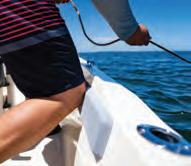
“ICAST is the cornerstone of the global sport shing industry,” said ASA President Glenn Hughes. “ICAST is where connections are made that create business opportunities for our industry. It’s also where most new products make their debut into the shing marketplace.”

Each year, this is the one can’t-miss event of the season for everyone in the outdoors industry. From shing guides to retailers, media and exhibitors of shing-related products and services, it’s a one stop shop, where your business might nd its next big money-maker.
Coastal Angler and e Angler will be at ICAST in force. Look for our logo-emblazoned team members perusing the aisles in search of

the next big thing. Stop and ask us about special ICAST free giveaways and deals on advertising.

If you’ve got a message to share, we’ve got the vehicles to spread your story to hundreds of thousands of shing enthusiasts.
At its heart, ICAST is about the New Product Showcase, where the coming year’s hottest new


gear is debuted for the industry. From a eld of hundreds of new tools, tackle, lures, electronics, apparel and more, the following pages contain some of our favorite industry innovators right now.
For more information, go to www.icast shing.org.

Okuma Sarasota Rods are the epitome of strength and versatility. Built with a 24-ton or E-glass blank, they feature Okuma’s UFR-II: Ultimate Flex Reinforcement rod tip technology for the ultimate in lifting power and durability. Elevate your experience with eight spinning, casting, and trolling models designed to exceed your expectations on the water.


| okumafshingusa.com







































































































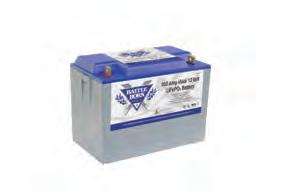












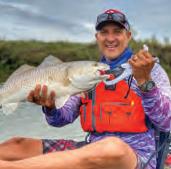




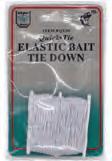



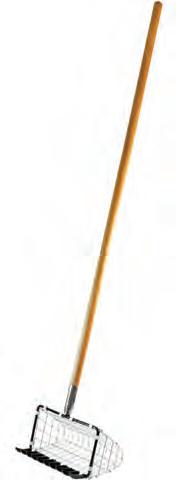

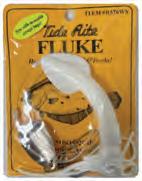
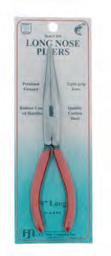





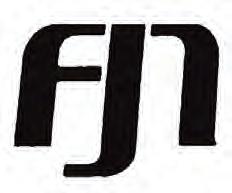







ICAST SPECIAL DISCOUNT

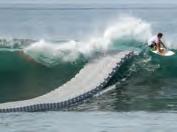

Lasting 2-3 times longer than wooden, concrete, and aluminum docks, our modular foating system is the preferred dock choice for residential, commercial, marina, liesure, and other applications. Customizable and confgurable for boat docks, liesure and recreation docks, and drive-on jet ski and personal watercraft!
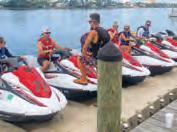

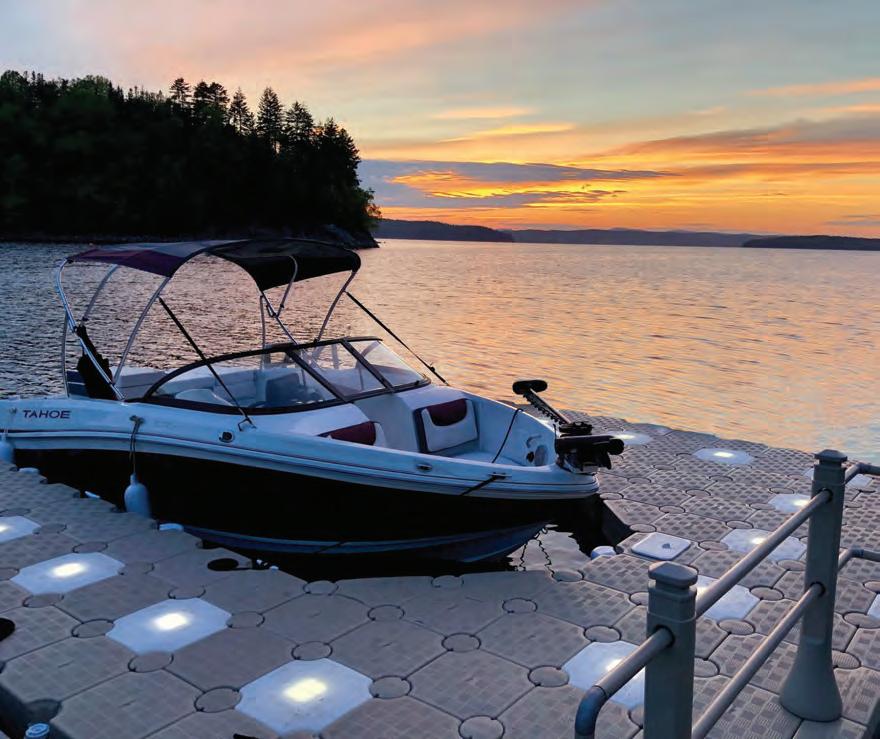
•High-quality plastic
•Environmentally-friendly
•Guaranteed for 20 years
•Near-zero maintenance
•Completely customizable
•UV and pollution resistant
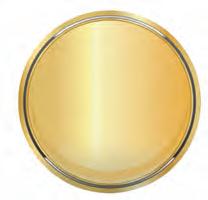
www.candockcf.com


It’s summertime here in the tropics and I don’t know about you, but it’s been hot out on the water. For the last 2 months, I have been fishing under the shade of the bridges up and down the overseas highway but now that the silver kings are moving away from the bridges, I find myself back out in sunshine and by mid-day the bimini top has been going up.
My fishing for July will move from fishing locally to heading back to the Flamingo area and leaving early especially on those calm days where I will concentrate on shorelines for snook or juvenile tarpon. It is the perfect time for a family trip if you want to introduce your kids to the beauty of the Everglades. I have been fishing the Glades since junior high and love everything about it, as there is nothing like witnessing a pod of dolphin chase down a school of mullett or an osprey swoop down and grab a fish to feed its baby in one of the many nests you will find on the mangrove shorelines.

The fishing can be great with so many species and we are so lucky to have this National Park so close and accessible to us whether you are leaving the

Islamorada area or driving in from Homestead. If you have never fished the Everglades, I would love to take you over for a day of fantastic sightseeing and fishing. And If dinner is more of what you’re looking to catch and the weather is conducive, it’s the perfect time to head out to catch a Mahi Mahi.
I have some great reports from some offshore guys finding the fish anyway from 400-1500ft, so get out on the water and look for the weed lines or is you have Sirus XM, turn on the fish mapping and follow the directions on the screen. I use it every time I go offshore and can honestly tell you it makes a difference and with the cost of gas these days it will direct you to the right areas to start searching. I like to carry a good pair of binoculars and scan the horizon for floating debris and birds as they head over to what I find. If you can take along some live bait, you are ahead of the game, and if that’s not possible grab a pack of frozen ballyhoo and thaw them out on your way out. Good luck out there, stay cool, and if you want to get out with me give me a call or stop by the Lorelei to say hello!
— Contact Capt. Greg at 305.393.3327 or email gregpoland@icloud.com

Instagram: gregpoland Facebook: Fishing in the Florida Keys with Capt. Greg Poland



It is officially summer in the Keys and my favorite guilty pleasure is snorkeling and freediving our many marine sanctuaries on the reef. Harvesting of marine life is prohibited in these sanctuaries and it’s almost as if all of the sea creatures know it! I have had the exquisite privilege of swimming with marine life in these sanctuaries that most people only dream of, and every day is different.
Taking my charter guests out snorkeling these areas is great fun; especially with first timers or children. Sharing this underwater paradise with people who have no idea what lies below the surface is fulfilling beyond words. When I have a guest who is a bit spooked and reluctant to get in, I simply take their hand and never let go as I guide them through an underwater paradise they never imagined possible.
The extensive variety of live coral is stunning. Mountainous and Lobed Star Coral, Finger Coral, Brain Coral, and Fire Corals (just to name a few) are healthy and abundant along with plenty of sea rods and colorful fans. Sponge varieties such as Red Boring and Branching Vase accent this underwater landscape as well. Fish which seem almost too pretty to be real, with colors and shapes that will fascinate even seasoned snorkelers. Angelfish, Parrotfish, Damselfish, Hogfish, Trunkfish, and every variety of snapper, plus so many more I couldn’t possibly list them all. Then there are the bigger, more impressive creatures like Giant Tarpon, Nurse Sharks, Blacktip Sharks, Stingrays, and Barracuda just hanging about or cruising through.
I’ve been lucky enough to treat my clients to Spotted Eagle Rays that are so graceful they look like effortless flying carpets moving through the water and varieties of sea turtles that not so long ago were endangered and almost never seen.
Just a mere week ago I had a solo snorkeling experience with a very large and very old (I could tell from the large barnacles clinging to his massive shell) Hawksbill Turtle, which is still on the critically endangered list. As I free dove with this amazing turtle and swam alongside him, but far away enough to not disturb him, he seemed to be observing me just as intently as I was him.
All of that beautiful warm water is also the major contributor to our harsh summer storms. They usually pass quickly, and are beautiful to watch from a distance, but can contain extreme thunder and lightning. Try to wait them out or navigate around them for safety, but enjoy the amazing show from a distance, nonetheless.
The clearest of water with unusually warm temps, brings forth amazing life under the surface that one has to see for themself to truly appreciate, and our dazzling summer storms make summertime in the keys magical.

Book your summer snorkel trip with me and let me change the way you look at the ocean forever!

— Come out fishing with me by contacting me at: floridasaltycowgirl.com | 813-610-0078






The month of July! The middle of summer. What a great time to be fishing in the Florida Keys. As the summer season continues the fishing stays hot with great action, both offshore and on the reef.



On the offshore scene the great mahi fishing that we start to experience in late spring early summer should continue through the month of July and into late summer. Every day is different, but usually this month we’ll have plenty of slick calm days. Some beautiful weather to head offshore, running and gunning in search of these fish. In addition to the dolphin, or mahi-mahi, we should have some pretty good blackfin tuna action available on most of the humps and seamounts. One tip, keep in mind that first thing in the morning or late in the afternoon can be a great time to target the tuna. We’ve also been seeing quite a few wahoo this summer, which has been a nice bonus.
On the reef the snapper fishing is usually red hot! They’ll be yellowtails and mutton snapper available, but the star of the show and main focus on the reef in the middle of the summer are usually the mangrove snapper. The mangrove snapper will be spawning on the reef and readily available. Often you can catch a mix of snappers drifting baits back to yellowtail and mangrove snapper in the upper water column in your chum slick on light tackle with bigger mangrove snapper and mutton snapper available especially with live baits such as pichards or cigar minnows on the bottom.
It’s a great time of year to get out fishing and try to beat the heat. It’s always a little cooler offshore than it is back at the dock. On many of our trips we’ll even budget a little bit of time to stop at the sandbar for a quick dip to cool off on our way back to the dock. So come on down, and let’s get in on the action!
— www.captaineasycharters.com
You can reach Captain Bruce Andersen at Capt. Easy Charters, MM 85, call 305.360.2120 or email at: captbrucekey@comcast.net







 By: Beth Steele
By: Beth Steele
Keys fishing has been exceptional for all our amazing captains as we’ve seen some great pictures and videos so far! Saying I’m happy to be back offshore would be the understatement of a lifetime!

To get ready for this season, I had my boat serviced and renewed my HMS permit. To all my captain friends - please make sure if you’re sword fishing that both your permit and fishing license are up to date.
My first trip out was absolutely epic as I caught and released a mako. After two more drops, I snagged a 182lb swordfish! My next trip out I caught a huge golden tile, 14 rosies and a snowy grouper while deep dropping. Before that I tagged and released a smaller swordfish. I have to get all my deep dropping in now since the rules have changed with FWC. BTW, it’s always a great idea to check the FWC rules and regulations on a regular basis as they tend to change more frequently than ever.
On my last trip, I caught 11 rosies, 2 barrel fish, and another snowy grouper. Along with these great catches, the seas were so beautiful and looked like glass as 1-2ft seas make it for a hot and fun fishing day.
As much as swordfishing is my favorite, deep dropping is always a blast since you never know what you’ll pull up from the deep blue ocean. Make sure to book your next fishing charter with Hooker Booker! Here fishy fishy!

 — Beth Steele | Owner, Hooker Booker LLC | fishing@hookerbooker.com | @hookerbookerllc
— Beth Steele | Owner, Hooker Booker LLC | fishing@hookerbooker.com | @hookerbookerllc









SCAN TO SHOP!

USE CODE: CAM10 FOR 10% OFF!

www.theknottydawg.com



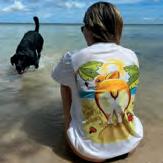




The Knotty Dawg is an apparel and dog accessory company that gives back to animal shelters and rescues in need. Owners Samantha and Kevin Mesa mixed the love of their lifestyle, dogs, and charity to create relatable and meaningful products. The brand is dedicated to and inspired by the couple's two pups, Beau and Buddy. Both rescued from local shelters. With thousands of amazing dogs in shelters, Samantha and Kevin want to use their brand to not only share their dogs' stories but also to inspire and educate people about adoption.
@TheKnottyDawg




















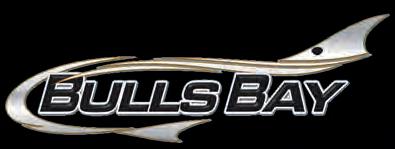





















Iam always asked this question, when is the best time to spearfish? The answer remains the same, summertime! Don’t get me wrong, I love our winter/spring Wahoo fishery, but there is something special about the Florida Keys in the summer. Warm water, no wetsuits, crystal clear calm seas, and an abundance of fish to choose from in many different water depths. No matter what experience level you are, free diver or scuba diver, the summer months in the Florida Keys have a lot to offer!
Spearfishing with kids or simply taking it easy freediving some shallow spots, the summer mangrove snapper spawns are never a letdown. For a few special months, large and mature mangrove snappers move into the shallow patch reefs to spawn in large numbers. When you find them, you won’t see a few, you will see hundreds. This is a great opportunity to introduce spearfishing to young freedivers. If you are an experienced diver, this is the time for you to strengthen your pole spear skills and dial in your Bahamas gear. I enjoy using my pole spear every chance I get, and this is the perfect opportunity. Although Wahoo are hard to come by when the water warms up, Mahi Mahi are generally plentiful. Reading this, you may be surprised to hear that spearing Mahi is an option and most people have that same reaction. If you have offshore fished before, then you know Mahi are generally found in schools. These fast growing, aggressive eating, schooling Mahi are the perfect fish to target for someone looking to get into pelagic spearfishing. It’s the full bluewater experience, with similar gear, but without the depth! Mahi can be found in large numbers, chasing bait on the surface. This makes them a great fish to target while freediving, even though you are in deep blue water, the fish will only be a few feet below the surface. These fish can range from 10 pounds to well over forty plus pounds, the largest Mahi we have ever shot was a beautiful 45-pound Bull Dolphin. If you plan to head offshore to target Mahi, make sure you shoot a mid-sized gun with a reel on it. These fish swim fast, you will need a gun that is easy to maneuver in the water. The reel is also a must, when you shoot one, they will put on an amazing show and you will want that line. Be patient when you are looking for these fish, the ocean can feel like a desert at times but remember to put your time in and keep looking. It does not take much to find Mahi and when you do it’s nothing short of incredible.
All things being equal, my favorite fish to target in the summer is Grouper. I will shoot one, maybe two, Black Grouper each year. There is a lot of meat on these fish and if you choose the right one, it will feed you for a long time. Islamorada is blessed with a very healthy Grouper fishery, just about every spot we go to has at least one nice Grouper to shoot. This allows you to really be selective and target the larger fish. What is amazing about mature groupers is how smart they are, it takes an experienced hunter or angler to put one on ice. These fish are generally in deeper water, they require a longer breath hold and the shot needs to be placed just right. They also fight hard, so many times it’s not possible to shoot and surface the fish on one dive. Shooting them is one thing but getting them out of the coral or a wreck is another challenge. A quiet water entry, top-down angle, and breaking eye contact are all techniques that help when hunting Grouper. If they rock up after a shot, keep tension on the line and head to the surface. Groupers expand their bodies and gill plates to hold position when shot or hooked. Keeping tension on the fish will slowly wear them out and make it easier for you to retrieve on the next dive.
When you’re ready, have your buddy keep tension on the fish from the surface, while you dive down the line to where they are rocked up. Get your hands on the fish and push them forward while twisting. This will force them to release the grip they have and allow you to easily pull them out. Enjoy every part of the fish, there is a lot that often gets thrown away. The filets, cheeks, collar meat, and even the ribs all make great cuts with meals to enjoy from each part.
For anyone looking to spearfish, the summer months in the Florida Keys have a lot to offer. From spawning Mangrove Snapper, to offshore Mahi Mahi, there is always a fish for every diver. Be courteous to other boats, both fishing and diving, fly a large visible dive flag, and respect everyone’s ability to enjoy the water.

Happy hunting and safe diving!
— Capt. Tony Young can be reached at Forever Young Spearfishing in Islamorada, FL at 305-680-8879










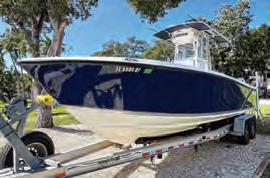
















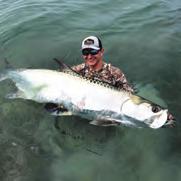

The 2023 lobster mini-season is scheduled for July 26 and 27 and that means coastal waters will be flooded with lobster hunters angling for this year’s bounty.
“Mini-season is a great time for residents and visitors alike, and I want to ensure everyone is aware of the law and has fun in a responsible, and safe manner,” said Monroe County Sheriff Rick Ramsay.


A new website, www.keyslobsterseason.com, includes interactive videos with need-to-know dive and boating safety tips, up-to-date rules, and regulations such as daily limits, harvesting techniques, and no-take zones. Marine thefts commonly happen in the Florida Keys and thieves may see mini-season as an opportunity to target people who aren’t being careful with their valuables. Make sure you remove electronics, fishing, and diving gear from your boat.

Keys to remember:
• If you’re keeping your vessel at a marina, talk to the manager about security measures in place.
•Always stow and remove fishing gear and valuables on your vessel.

•Use security video wherever possible and link it to your phone using Bluetooth technology.

•Drive carefully on and off the water. Pay attention to those around you. Be patient.
•Drunk boating is as illegal as drinking and driving
Crime Stoppers offers a reward for the arrest of anyone in a felony criminal case.


If you see anything suspicious, call the Sheriff’s Office immediately! It is our job to check out suspicious activity. Your call may be the one that helps us catch the bad guys!
If you see something you think may be suspicious. Call CrimeStoppers with any crime tips: 1-866-471-8477 Submit tips online at www.floridakeyscrimestoppers.com

Presented by Island Arms and Indoor Range
June 2nd thru 4th 2023, Key Largo, Florida Keys

Reel Tight Marine Detail/ Island Time WINS

$36,800.00 +++ AT SKIPPERS DOCKSIDE.
Skippers Dockside Restaurant hosted the 9th Annual Skippers Dolphin Tournament presented by Island Arms and Indoor Range with eightythree teams made up of 322 anglers competing for over $90,000 in cash plus amazing trophies from King Sailfish Mounts and Costa Del Mar sunglasses. Anglers were allowed to weigh two fish on Saturday and two on Sunday, but it would be the combined weight of three fish that would determine the winners.
Reel Tight Marine Detail run by Carlos Padron along with his 3 anglers; Manny Lemus, Alex Murphy and Nicholas Perez of Miami, FL got to the winners circle weighing in 32.1 pounds of dolphin. The combined weight of their largest 3 fish, an 18.6 pounder plus a 9.3 and 4.2 would win $28,360.00! The 18.6-pound dolphin caught by Manny also won the team $8485.00 for the Largest Fish on Saturday.

Second Place team was Hurricane Fever III captained by Chris McNally caught a combined weight of 29.5 pounds to win $16,270.00. The team of Corey Manzan, Michael McNally & John Wick from Hollywood, FL and Logan Pathman of Miami Beach, FL weighed in fish at 19.7 and two at 4.9 pounds. Michael McNally also won $4895.00 for Second Largest Fish on Sunday for the 19.7-pound dolphin.
Third Place team was 3 B’s Gang with anglers from Key Largo, FL and Lake Shores, TX catching a total of 28.7 pounds winning over $9,100.00. Peggy Gentzel also won $1000.00 for 2nd Largest Fish Lady Angler with the 8.9-pound fish.
Fourth Place team was Yeti of Knot with 6 anglers from Naples, FL and Marathon, FL, with fish totaling 27.4 pounds winning $4,090.00.
Fifth Place team was won aboard the Executive Decision captained by Chris Ware with mate Mike Kasten. Anglers Emily Faulkner, Mike Kasten, Anthony, Jill, Vinny & John Paglia of Ocala, FL caught a total of 26.7 pounds winning $1,000.00.
Sixth Place team was Paul’s Fault from Miami, FL. The team of two had a total of 24.4 pounds winning $500. Natalie Acedel also won $2000.00 for Largest Fish Lady Angler plus $500.00 for 3rd largest fish day 2 with her 14.4-pound dolphin.

Second Largest Fish on Saturday weighing 14.7 pounds won $1000.00 for Rowland Goodman of Islamorada, FL fishing aboard Legasea. Third Largest fish on Saturday weighing 14.3 pounds won junior angler Tyler Carvajal $500.00 aboard Type 1 Sportfishing of SW Ranches, FL. Dream Weaver angler Digger Rodamer of Naples, FL won $3990.00 for his 13.8 fish on day 1. Largest fish of the tournament weighing 44 pounds was caught by Ryan Clevenger of Grandville, OH aboard Bearded Snapper winning $8300.00 for Largest Fish Day 2.
Largest Senior Angler winner was Paul Attales of Lake Charles, LA fishing aboard Enigma with Captain Shannon Attales won $1,000 catching a 9.1-pound dolphin.
Junior anglers competed for top three places with Tyler Carvajal taking first place with his 14.3-pound fish winning $500.00. Second would go to Matthew Rangel of Hialeah, FL winning $250.00 with a 7.8 pounder and third to Islamorada, FL angler Hudson Wampler winning $100.00 with a 7.7 pound dolphin.




Largest other species fish winners each took home King Sailfish Trophies and $750.00 each including Meant To Be angler Earl Johnson from Davie, FL with a 9.9 pound Kingfish and Glory Glory’s Christopher Taylor of Miami FL caught an 18.8 pound Tuna. Bella Vita’s angler Reid Nachtogal of Ft Lauderdale, FL who landed a 35.5-pound Wahoo donated his winnings to Mote Marine, the designated charity for 2023.
Skippers Dockside Restaurant showcased their fabulous food for the kick-off party, which was sponsored by Gus’ Toy Box and Contender Boats.
The awards party which was done up right with perfectly cooked smoked brisket, pulled pork with all the fixing’s and followed by amazing deserts!!!
For information visit: SkippersTournaments.com









For a testosterone-fueled offshore angler in the Florida Keys, fishing from a kayak is admittedly a tough sell. It’s just too far to travel with paddle power. But for the nearshore and inshore angler, a kayak offers myriad advantages. Some are obvious; many are not. Let’s explore some of those advantages..




Many of you know my favorite type of fishing is sight fishing in shallow water. This requires stealth, and a kayak is super stealthy! I’ve many times been so close to permit and bonefish that I simply tossed my offering with an underhanded lob and watched the fish inhale it within 10 feet of the kayak. The fish never knew I was there. It’s almost unfair! And this stealth also transfers to other members of the animal kingdom. Dolphins, manatee,
turtles, birds and more are much less concerned about me when I’m in a kayak, making wildlife encounters and photography much more common and productive.
In a kayak, you are the captain of your little vessel, you make all the decisions, and you own all the successes (and failures) of your fishing adventures. No waiting for your buddy at the dock, only to find out he has to cancel. No listening to him (or her) whine about their life all day. No compromising or arguing about where to fish, how to fish, or what to target. And poling a flats skiff by yourself (without the counterweight of an angler on the bow), then trying to execute the moves necessary to quietly get your offering to the fish in the short window of time available is almost impossible. But in a kayak, with a bit of practice, you really can do it on your own.
But maybe the best part of allkayak fishing is FUN! Even smaller fish seem bigger from a kayak. And bigger fish will blow your mind, turning your yak in circles...
Kayaking in the Keys is wonderful exercise. Much like bicycling around the islands, you can make it as easy or as challenging as you’d like. You don’t need to be in Olympic condition to enjoy a few hours on the water. Plus, the fresh air and sunshine will make you feel great!

To be fair to the motorized folk, yak fishing has limitations, with the main one being limited range. Which means you have to be very thoughtful when pick your location to fish. You can’t drop the motor and run 5 miles to catch a favorable tide on a distant flat or patch reef. And if weather threatens the day’s proceedings, you need to have a plan B, since you aren’t going to outrun anything at a cruising speed of 3 knots.
But maybe the best part of all - kayak fishing is FUN! Even smaller fish seem bigger from a kayak. And bigger fish will blow your mind, turning your yak in circles, towing you around, and giving you an incredible sense of accomplishment, knowing you did it solo with no engine necessary. Now get that paddle moving and get out there!

Trolling 101. Some say, fishing is a sport some say, or fishing is an art. I think trolling is one of the fine arts of fishing. There are many forms of trolling. It’s important to know when to troll where to troll and what to troll for and with. I’m going to go over several trolling techniques in this article.
Trolling for mahi. Most avid mahi anglers would agree that a six-knot troll is the appropriate speed for trolling for mahi. Even though 6 knots is the best trolling speed for mahi keep in mind sometimes the current is in your face and sometimes the current is at your back. It’s important to know the current speed in order to adjust your trolling speed for example if the current is going 3 knots at your back then your speed should be adjusted to 9 knots. When trolling a rigged ballyhoo, it’s important for your ballyhoo to slither and hop behind the boat. If your ballyhoo is only slithering, you’re going to slow if your ballyhoo is only hopping you’re going to fast, if it’s slithering and hopping you’re going just right.
Trolling for a wahoo. If you are high speed trolling for a wahoo using an in-line weight with a plastic skirted tormentor lure for example, you should be going between 11 and 14 knots. If your low-speed trolling for wahoo with a nomad lure for example, your ideal speed is between 6 and 8 knots. Whether you’re high-speed trolling, or low-speed trolling for a wahoo, I like to have my long line at least a football field and a half to two football fields behind the boat. Remember wahoo hit with such velocity that it’s important to keep your drag as loose as possible during the troll. It’s easy to tighten your drag during the fight, it’s almost impossible to loosen your drag in time to save the fish.

Trolling for grouper. Depending on the depth of water that you’re trolling, you could use a stretch 20 stretch, 30 or stretch 40 some people even troll for grouper using a planer and my favorite speed while trolling for grouper is 3 knots. I like to keep my trolling line as short as possible, but long enough to get near the bottom where grouper dwell . I like to set my drag a little tighter when trolling for grouper so when the grouper hits, we can pull the grouper away from the rocks and reef immediately after the strike plus a grouper’s mouth is a lot stronger than a pelagic’s mouth, so I’m not as worried about
pulling the hook on a grouper.
Trolling for pelagic’s, such as king, fish, and bill fish. I like to bump troll for a pelagic’s using live ballyhoo or large live pilchards. Since you’re bump trolling and using live bait that are able to swim left or right, I’m It’s important to have one line long 100-150 yards or so, and have another line short 50-75 yards or so. By having one line long and one line short, you’re able to make sharp turns without worrying about your baits swimming into each other and tangling up the lines, plus by having one line long and one line short, if a pelagic hits your short line and misses the bait or misses the hook, you always have a long line past your short line to give the gamefish another shot at the title.
Trolling for tuna. When we troll for tuna at the Marathon Humps and like the troll long and slow, 200 yards back at three or 4 knots. Our favorite bait to troll for tuna at the Humps is black sand eels. When we see white turn birds which we also called tuna birds and a big flock, we call birdnato’s chasing the tuna very quickly will do a run and gun control. Running in troll is dragging a lure such as a worm or a tuna dart behind the boat. Chasing the flock of birds and slowing down to 6-8 knots right when you catch up with the birds and troll through the birds as best as possible, hoping the birds will start diving and dipping behind the boat in your spread.
#6 general trolling tips. The first rule in effective trolling is to make sure whatever bait you’re trolling behind the boat doesn’t get weeds on it. It’s very rare for any game fish to hit a trolling bait with even a speck of weeds.
I’ve always thought it was funny that game fish won’t hit a bait with a weed on it, but many times when we open up their stomachs when we clean the fish, we find weeds in their stomachs. Another thing to remember about trolling is that if you’re not getting a strike try to slow down a little bit or speed up a little bit or cut to the left or cut to the right or change lures or check your rig value or check your lab value that your bump trolling behind the boat to make sure they’re not dead or gimpy. Another thing to remember about trolling is to be patient as many times you have to put in the time and look for frigates, sea birds and floating objects to change your luck.
For a charter with Ana Banana call or text Capt. Joel or Jojo Brandenburg at 305-395-4212 or 813-267-4401. Or visit us in person at Ana Banana Marina 11699 Overseas Hwy Marathon Fl Keys


— For a charter with Captain Joel or Jojo Brandenburg of Ana Banana Fishing Company in Marathon Florida Keys call cell 813-267-4401 or office 305-395-4212 or visit www.marathonkeyfishingcharters.com or visit us in person at Ana Banana Marina located at 11699 Overseas Hwy Marathon Florida Keys. Look for the big yellow Ana Banana sign with antlers around it.











If you have a catch to brag about send your picture and caption to: flkeys@coastalanglermagazine.com



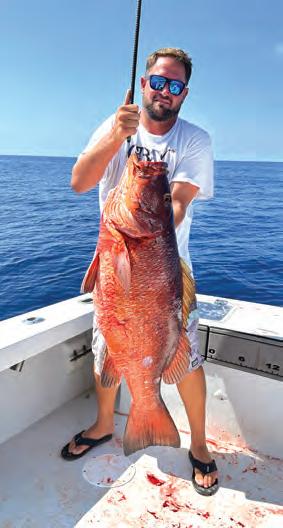


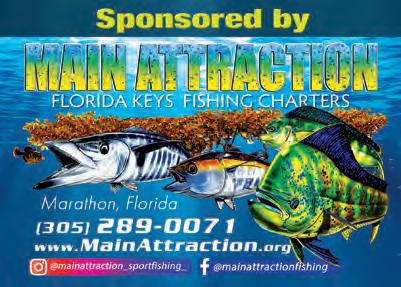
 Carla landed this nice Tripletail on the Reel Therapy with Fun in the Sun Charters w/Capt. Craig.
Mason with a haul of Mahi fishing the recent Skipper’s Dolphin Tournament
Capt. Ben Zdan of BenOfishal Sportfishing holding a Cubera Snapper.
Marinel age 13 landed this beautiful Golden Tile off Cudjoe Key fishing with Dad & Grandpa.
Double hook up for Dad & Daughter aboard the SaltyValhs with Capt. Joey Eppy in KeyWest.
First Mate James Cotton, of Main Attraction Charters, holding up a stud Yellow Edge Grouper, caught while deep dropping off Marathon, FL.
Carla landed this nice Tripletail on the Reel Therapy with Fun in the Sun Charters w/Capt. Craig.
Mason with a haul of Mahi fishing the recent Skipper’s Dolphin Tournament
Capt. Ben Zdan of BenOfishal Sportfishing holding a Cubera Snapper.
Marinel age 13 landed this beautiful Golden Tile off Cudjoe Key fishing with Dad & Grandpa.
Double hook up for Dad & Daughter aboard the SaltyValhs with Capt. Joey Eppy in KeyWest.
First Mate James Cotton, of Main Attraction Charters, holding up a stud Yellow Edge Grouper, caught while deep dropping off Marathon, FL.
 Tim Barefoot
Tim Barefoot
We are seeing a heavy line of sargassum right now. Here’s how to make the best of it.
Along with grass comes sh. We’re having a great dolphin year, with some nice yellow ns and wahoo in the mix. e grass is a wonderful thing if you know how to take advantage of it.
It’s a well-known fact that the surface trolling bite slows as the sun rises to the 10 to 11 a.m. position. is is the reason to get baits down where the sh are, rather than continuing to troll surface baits while the one “meat stick”—the deep planer rod—gets all the bites. Tuna and wahoo don’t wear Maui Jims. When the sun penetrates deeper into the water, they simply go lower in the water column.
And… who says you have to be moving at 6-8 knots to get bites? Why not slow down and put several lines down where the sh are? It can result in steady, sometimes multiple hook ups. ere are several ways to accomplish this. You can use downriggers with release clips, use heavier trolling lures that fall when you occasionally take the boat out of gear, or use planer lures coupled with a slower speed to get baits down.
For example, a beautiful swimming (frozen) squid or ballyhoo on the downrigger is a ringer for the wahoo and tuna bite. An arti cial squid with an attached natural bait on a planer jig head or a deepdiving plug will also get bites. In addition these choices, a spread of slow-trolled live baits down deep is the ultimate o ering. We have several videos detailing the options listed above on our website.

With all the sargassum grass this year, this may be an especially attractive alternative to the standard 7 knots. When you’re constantly “shaggin’ grass,” you’re not as e ective, and it’s not good for moral when


deck hands ght more grass than sh. If you slow troll down a nice weed line with beautiful baits down deep in the strike zone, chances of getting bites are much better than shaggin’ grass at normal speed. Find structure and bait near a weed line and you’ll have the scenario for success. With or without structure or marking bait, the weed line is home to all types of life. We’ve cleaned yellow n tuna with a double handful of le sh in their stomachs the size of a quarter and smaller, along with small bit of grass.
If the weeds are not too scattered, troll as normal to nd the sh. When the sun gets up, slow down and concentrate on the areas you had bites earlier. Remember that the weeds are moving, along with everything that lives and feeds around the mats. Keep an eye out for other items oating in the grass mats to help keep up with your relative location.
For more from Tim Barefoot, go to barefootcatsandtackle.com.
As I write this, the largest mass of sargassum ever recorded is making its way to the Florida coast. For months, forecasters have been bemoaning the mess this 5,000-mile-long weed patch will make on our beaches, but I’m looking forward to what it brings.
Prey species live in the seaweed, and predators congregate around these weed lines. ere are going to be many di erent species of sh moving in closer than we usually get. Many anglers will enjoy chasing the larger predators; however, it’s fun to catch what we call peanuts, which are the small er dolphin sh that school up around the weeds.
e most distinguishing feature of dolphin sh is the bright neon green, yellow and blue coloration throughout their entire body. Dolphin have a long slender body, and the peanuts are typically 2 to 3 feet, with weights from 5 to 15 pounds. Dolphin get much larger than this, but the big ones don’t exhibit the same schooling behavior.
An amazing feature about dolphin sh is their dorsal n, which starts at the skull and continues all the way to the tail. To determine gender, male dolphin will have a more pronounced forehead, which almost becomes vertical with a 90-degree angle. Unlike most species of sh, the males tend to be larger than the females and are known as “bulls.”
Dolphin inhabit subtropical and tropical waters throughout the entire world. ey live o shore in the 70- to 300-foot depths. eir spawning season runs from April until August, as long as the water is warm enough. Dolphin broadcast spawn in current to ensure a higher rate of fertilization. Once the young hatch, they take shelter in sargassum patches or oating debris, which also provides a source of food since other juvenile sh will be hiding there also.
Fish in the big schools hanging around sargassum patches will usually be on the smaller side. So, you’ll want to use smaller baits like pilchards or thread ns and free swim them around the weeds. You might see a school of dolphin swarming your bait and ghting over it. eir bright colors and darting movements make them easy to spot.
Another option is to use small bucktail jigs or even 3-inch swimbaits. You can grab their attention by working lures like injured bait sh, and this is a great way to lure them out from under the debris.


While shing these patches, a great way to target larger sh is to sink a larger bait below the school. Larger dolphin and wahoo o en feed on peanut dolphin. It is illegal to use peanut dolphin as bait, but you could use ballyhoo, blue runner or even large thread ns.

e IGFA all-tackle world record dolphin weighed 87 pounds. It was caught by Manuel Salazar in the Papagayo Gulf in 1976.
Emily Rose Hanzlik holds 62 IGFA world records in various categories. She hails from West Palm Beach, where she has a part time Bow n Guide Service as well as shing classes for Jr. Anglers. Find her on social media @emilyhanzlikoutdoors.



NOAA Fisheries has announced that a closure to recreational harvest of red grouper in federal waters of the Gulf of Mexico will begin on July 21 and continue through the rest of 2023.

Perfect Vacation Getaway for Fishing, Boating & Outdoor Enthusiasts





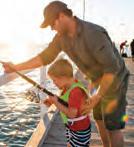
e closure was spurred by landings information, which indicates the 2023 recreational annual catch target of 1,840,000 pounds gutted weight is projected to be met on July 20.
During the recreational closure, the bag and possession limit are zero for red grouper in or from federal waters of the Gulf. e prohibition on possession of Gulf red grouper also applies in Gulf state waters for a vessel issued a valid federal charter vessel/ headboat permit for Gulf reef sh.

If red grouper recreational landings exceed the annual catch limit (ACL) in a given year, the length of that following year’s recreational shing season will be reduced to ensure the recreational ACT is not exceeded in that following year.
For more information, visit www. sheries.noaa.gov.

Nestled on six lush tropical acres of pristine waterfront directly on the Indian River Lagoon, take a step back in time to experience the very best of Old Florida charm with modern conveniences and services to make your stay truly memorable and unforgettable.
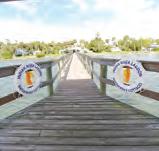


• FULLY FURNISHED 3 ROOM COTTAGES WITH FULLY EQUIPPED KITCHENS


Kingfsh Lodge includes a wide screenTV and bar for small gatherings

Sailfsh House features a wide covered wrap-around porch for larger groups
• Boat Trailer Parking on site w/ Water and Power
• 250 Foot Dock w/ Covered Area
• FREE Ice / FREE Guest Dockage
• Cable TV, Hi-Speed Internet

• 2 miles to the Ft. Pierce Inlet
• 12 miles to the Gulf Stream
• Laundry, BBQ Grilles and FREE use of our Kayaks





3011 N. Indian River Dr., Ft. Pierce, FL 34946 www.indianriverlagoonwaterfrontcottages.com Reservations and Information: (772) 349-2206


In 2018, when Hurricane Michael bowled over the Florida Panhandle, it decimated the shoal bass population in the Chipola River. e Florida Fish and Wildlife Conservation Commission estimates the population was depleted by 90 percent.


FWC is raising and stocking shoal bass to replenish stocks of this rare and native black bass. In May, 7,800 hatchery-raised shoal bass ngerlings were released into the river. is is the second consecutive year shoal bass were raised at the Blackwater Fisheries Research and Development Center near Holt, Fla. and then released into the Chipola River to enhance the wild population.
Shoal bass are one of four of Florida’s native black bass species, and this e ort marks the second time genetically pure shoal bass have been successfully raised at an FWC sh hatchery. Shoal bass are also a Florida Species of Greatest Conservation Need, which refers to native animals whose populations are of concern and are at risk or declining. e goal of raising and releasing these sh is to enhance the wild population to help maintain genetic purity and aid in the long-term conservation of this unique species of Florida black bass.
e Chipola River originates just north of Marianna, owing south for 95 miles through Jackson, Calhoun and Gulf counties where it joins the Apalachicola River. Currently, a catch-and-release-only regulation is in e ect for shoal bass on the Chipola River and its tributaries. Any shoal bass that are caught must be released alive immediately and possession is prohibited.
For more information, visit MyFWC/Freshwater.




During the 2023 Emerald Coast Open, 144 competing divers removed 24,699 invasive lion sh from the Gulf of Mexico. With support from Yamaha Rightwaters as well as many local, national and international conservation-minded organizations, the annual event set records for largest lion sh ( ve times) as well as the number of lion sh caught in both the pre-tournament and main tournament.

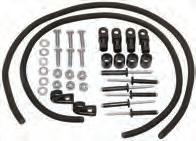

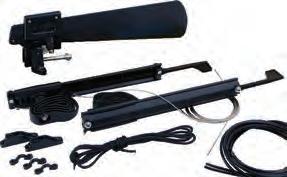

e mitigation of aquatic invasive species is one of the four pillars of the Yamaha Rightwaters mission,” said Martin Peters, Director, External A airs, Yamaha U.S. Marine Business Unit. “ e Emerald Coast Open helps foster healthy marine environments in the Gulf while educating the public about the damage a large lion sh population can cause. Yamaha Rightwaters will continue to support this tournament and applauds the e ort to help the Gulf of Mexico thrive as a strong shery.” sh prey on more than 167 di erent native sh species and can reduce some reef sh populations by up to 90 percent. ey are capable of eating sh two-thirds their size, and one lion sh can consume roughly 20 sh in a half hour.
“Since its inception in 2019, the Emerald Coast Open helped remove more than 72,000 total lion sh from Gulf waters,” said Alex Fogg, Coastal Resource Manager, Destin – Fort Walton Beach and Emerald Coast Open Organizer. “ e tournament not only yields immediate results and improvement within our sheries, it also demonstrates that catching lion sh is fun – and they are tasty! We’re glad to have the support of Yamaha Rightwaters and look forward to developing our relationship as we begin to plan for the 2024 tournament.”
To learn more about the Emerald Coast Open, visit emeraldcoastopen.com.



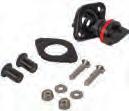









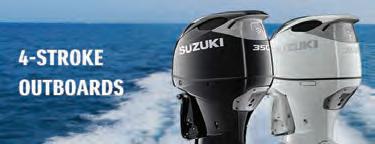
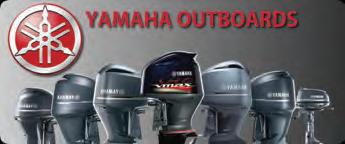










On the Gulf side, Florida anglers are looking at a pretty solid red snapper season this year, with summer dates from June 16 through July 31 and additional fall dates to pursue one of the South’s favorite game sh.

It’s a di erent story over on the East Coast. With the way the federal government has regulated snapper shing in the Atlantic over the years, anglers have come to count themselves lucky if there’s any Atlantic snapper season at all. is year’s allowance of two days—July 14-15— for recreational snapper harvest in the South Atlantic has anglers looking for ways to make the most of it.
From all reports, there are scads of red snapper out there. Catching the per-person limit of one sh should not be a problem. e key to a productive day that’s worth the gas is planning. Here are a few tips to help you make the most of the red snapper rally.


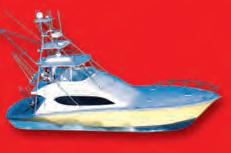

Load the Boat: With a limit of one sh per person, it’s time to load the boat with as many people as it will comfortably and safely hold so that you can ll the sh box with as many snapper as you are allowed. is is your two-day opportunity to ll the freezer with delicious sh. So, the more people you bring, the more sh you get to bring home. is is a great time to take kids. Kids love to sh, and they also take up less room in the boat.
Go With a Plan and a Backup Plan: For two days, it’ll seem like everyone with a boat is parked over every wreck and reef in the Atlantic. Get to the ramp early, and plan to be patient, because there will be a bunch of anglers with the same idea. Know where you hope to start the morning, but have several back-ups in case your honey hole doesn’t pan out. When you get there, if your graph doesn’t light up with life, don’t waste your time. Keep moving until you nd bait and sh.
Fish Big: With a one- sh limit, and no size limit, it pays to target the biggest sh down there. Fish live baits that are big enough to get past the smaller snapper down to 20-pounders. It wouldn’t hurt anyone’s feelings if a big grouper took the bait, either. is also limits the number of small sh you’ll give a case of barotrauma, which is a good thing.

Remember, use of a dehooking tool is required. ere is also a requirement for the use of non-stainless steel hooks. In waters North of 28-degrees N. latitude, the use of non-o set, non-stainless steel circle hooks is required when shing for snapper grouper species. A descending device is also required on board all vessels and must be readily available for use (attached to at least 16 ounces of weight and at least 60 feet of line).
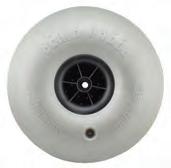
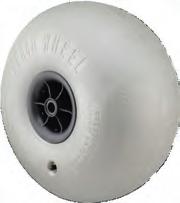
For more tips, go to coastalanglermag.com.













With excellent strength for line-to-line connections, the double uni is a go-to knot for connecting main lines to leaders. It is a quick and easy knot to tie, unlike some of the other line-to-line knots, so it’s a great option for on-thewater applications. Furthermore, it is very good for connecting di erent line types and diameters securely, which makes it the best knot for mono-to-mono or mono-to- uoro connections.

It’s also a good option to secure braid to uoro, and while it might not have the strength of the FG knot for this application, the double uni is much easier to tie and will save you some headache in real-world situations.
A disadvantage to the double uni knot is it’s a little bulky. Although it is an inline knot that keeps everything running in the right direction, the bump it creates at the connection and the two tag ends pointing in either direction can interfere with casting performance. e knot can cause some friction going through the guides. e double uni, however, is perfect for rigs where your leader will remain outside your rod tip. It’s also the right choice when casting distance and accuracy are not primary concerns. In most real-world scenarios, it will not inhibit casting ability enough that you’ll even notice.
For more tips, tricks and knots, visit usangler.com.








































































































By completing conservation projects, the Chambers High School shing team recently earned a private, in-person custom rod building class with Mud Hole Custom Tackle. ey were the winning team in FWC’s School Fishing Club Conservation Project Competition and completed six projects including cleaning up and building mono lament recycling bins for their local waterbodies to win the grand prize.
All student anglers participating in the FWC’s 2022-23 School Fishing Club Program were required to complete at least one conservation project to qualify for funding associated with the program. Prizes were o ered by Mud Hole, Toad sh and Pure Fishing to encourage teams to complete multiple conservation initiatives. e competition awarded points per club participation in a variety of conservation-minded activities aimed at reducing the impacts of plastic pollution.

“Congratulations to these young anglers for their dedication to conservation,” said Tom Graef, FWC’s Freshwater Fisheries director. “ ey are making a di erence by leading the way for the next generation of anglers with these creative conservation projects.”
Punta Gorda Middle School won the second-place prize, and A. Crawford Mosley High School won the third-place prize.

“Supporting youth education is so important to our mission at Mud Hole Custom Tackle,” said Anthony Youmans, Mud Hole’s Education Program Director. “We’re honored to contribute the grand prize in this year’s competition and are always supportive of FWC’s e orts to lead conservation projects here in Florida, our home state.”
Mud Hole Custom Tackle, based in Oviedo, is the world’s largest supplier of rod building and tackle cra ing goods and instruction. From rod building












and repairing, to y tying and lure building, Mud Hole is the leading e-retailer and mail order supplier to hobbyists, small manufacturers and large OEMs, worldwide. O ering a superior shopping experience at mudhole.com, rapid ful llment, stellar customer service, and world class online content and instruction, Mud Hole Custom Tackle is the trusted source for the rod building and tackle cra ing community.
FWC’s School Fishing Club Program welcomed 38 new and 14 returning student angling clubs in Florida to the program last year, supported by the Division of Marine Fisheries Management, the Division of Freshwater Fisheries Management, and the Florida Youth Conservation Centers Network. e clubs committed to complete the provided FWC curriculum and at least one conservation project. Club mentors provided support and hands-on training in knot tying and shing gear assembly, as well as assistance with the clubs’ local events to increase student anglers’ con dence in the sport of shing. Information about the 2023-24 School Fishing Club Program will be announced later this summer.
For more information, visit MyFWC.com/SFC.
The 2023 CCA Florida STAR competition presented by Yamaha kicked o Saturday of Memorial Day weekend. Four STAR tagged red sh have already been recaptured, but what you won’t believe is that none of the anglers were CCA members and registered in the competition. ose four anglers missed out on their chance at some awesome boats and packages, and that means all the boats and packages are still available.
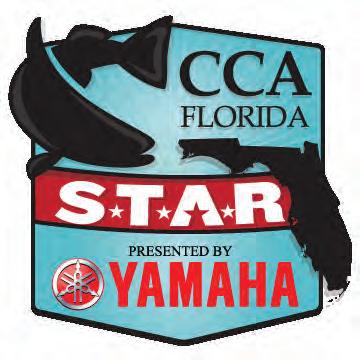
Registration for the summer-long competition is open until Sept. 4 and invites CCA members, non-members, anglers and non-anglers to take a shot at winning their share of prizes valued at more than $500,000 including boats, motors, electronics, tackle, scholarships and more. is event is about the shery winning, too. Participants become citizen biologists and citizen garbologists by submitting photos of their catch or garbage collected during the competition in the STAR app. In order to win, participants must take their entry photo on the 2023 CCA Florida STAR o cial measuring device, which can be picked up for free in any West Marine store or one of the many other STAR distribution locations throughout Florida. Find them listed on the STAR website.
“Every year we have lots of tagged red sh recaptured by unregistered anglers who are not members. We hope that this year, with more prizes, we will see more winners,” said CCA Florida STAR Director, Leiza Fitzgerald. “ e youth participation has been heartwarming, and to date STAR has awarded $800,000 in youth scholarships, plus in 2021 two youth anglers won a boat motor and trailer package that consisted of a 16-foot ski , 25hp Yamaha, Minn Kota Trolling motor and trailer. Every year there are over 100 winners In the STAR competition. Get registered and you could be one of them.”
e CCA Florida STAR competition presented by Yamaha has a division for everyone, from the non-angler to the experienced angler. It is comprised of 15 divisions targeting 12 inshore and o shore species, plus the Kick Plastic Trash Division presented by Papa’s Pilar which encourages cleanup of trash from Florida’s coastal waters. STAR’s signature Tagged Red sh Division o ers seven winners, ve adults and two youth, the choice of a Contender Boats 22 Sport, Path nder Boats 2200 TRS and a Carolina Ski 162 JLS. STAR has additional new Tagged Red sh sponsors with Dek Kat Boats o ering a 27 Flatz Kat and Sea Doo and Can-am o ering a fun package of a Trophy Fishing Sea Doo and the Can-am Defender. Each boat will be powered by a Yamaha, the competitions presenting sponsor. Be the rst winning tagged red sh angler for your choice of all these packages as your prize.
Once again in 2023, we have the ALTA SUPER STAR tagged red sh swimming in Florida waters. If it is recaptured, the winner will receive $50,000 cash! For the rst two youth anglers who win in this division, prizes include a tiller boat powered with Yamaha outboard, trailer, Minn Kota trolling motor and Humminbird electronics.
Each of Florida’s coastal counties have on average four tagged red sh for a total of over 160 prize-winning sh. e best opportunity to catch one of this year’s tagged red sh will be in Citrus and Charlotte Counties, STAR’s 2023 Destination Counties, which each have eight tagged red sh in their coastal waters.
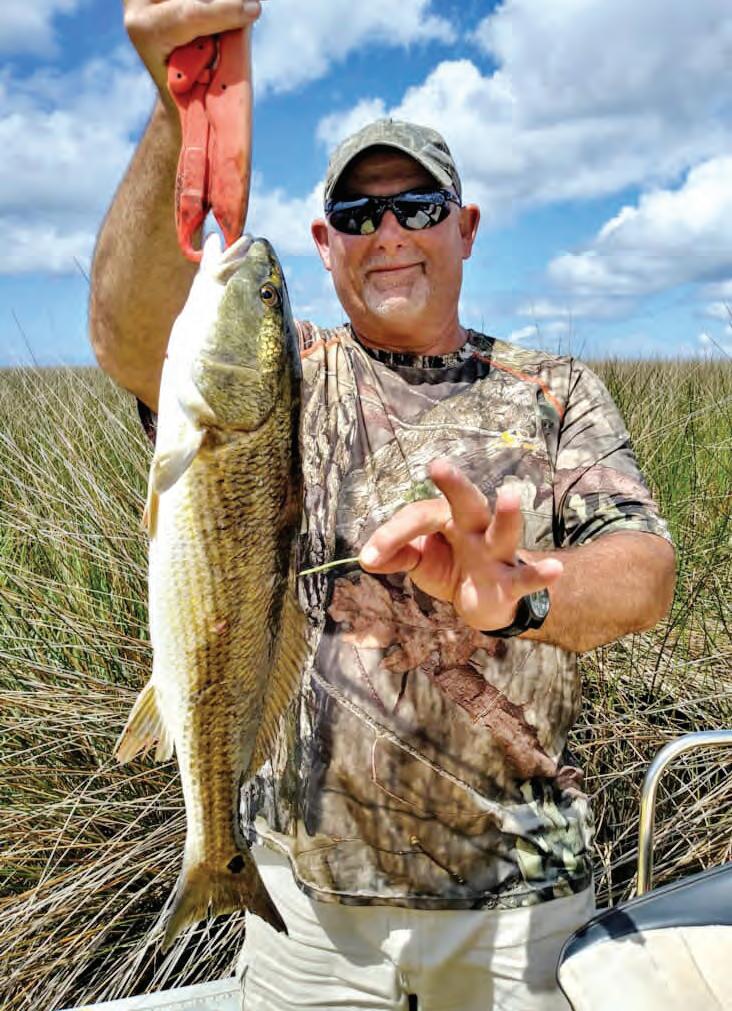
For the o shore anglers, the Tigress Outriggers and Gear Tagged Dolphin Division o ers one winner a $10,000 cash prize. e rst STAR registrant and CCA Florida member who catches a tagged dolphin will win. Twenty tagged dolphin (Mahi Mahi) were released for STAR in the lower Florida Keys.
STAR is a family-friendly competition, and CCA Florida youth members (ages 6 to 17) can participate for free. Kids are encouraged to submit entries in the Youth Scholarship Division presented by Realtree Fishing for an opportunity to win one of 12 scholarships totaling $100,000. Other divisions include the Power Pole Conservation Division, Bona de Kayak Division and Ladies Division as well as the Yamaha Guides which allows guides to participate when they are not on a charter for hire. Since most division winners are determined by a random drawing, it is not about catching the biggest sh, any size sh can win. Remember, it is very simple really, every sh you catch between now and Monday, Labor Day o ers the CCA member who is registered in STAR the opportunity to win their share of $500,000 in prizes and scholarships. You can’t win If you are not registered.
STAR is also a tool to gather catch data, it creates awareness for conservation, our sponsors and CCA Florida. Launched in 2015, the competition has set the bar for other shing tournaments to follow by implementing conservation-friendly alternatives such a catch-photorelease format and a trash division. Florida STAR focuses on conservation with its technology-based, CPR format and dedicated smartphone app which promotes the proper handling of species and allows participants who are members of CCA and registered in the competition to upload photos of their catch or trash buckets in the STAR competition and be rewarded for their e orts. CCA Florida also provides access to the data collected to other conservation organizations and universities to help educate the public and for use in their studies on conservation, habitat and stock assessments.
You can still register for STAR 2023. You have all summer and all the boats and packages are still available. To receive additional information on divisions, prizes and more, visit cca star.com or Facebook.
Put Orange Lake on your bass- shing itinerary for next spring. is 12,550-acre lake in Alachua County southeast of Gainesville is a springtime conveyor belt of big bass.
From February through April this year, 19 Orange Lake largemouths heavier than 10 pounds were reported to TrophyCatch, FWC’s big-bass recognition program.
Bass heavier than 13-pounds are given “Hall of Fame” status by TrophyCatch. Five 13-pluspounders have been caught statewide this year. Four of them came from Orange Lake, and three of those were caught in February.

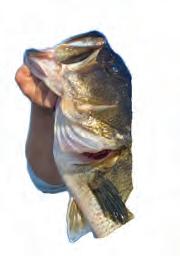
e most recent one we’ve heard of was a sh caught back on Feb. 7 that just popped up on the TrophyCatch Facebook
Kelly


a giant 13-pound, 3-ounce monster swimming a
Man… that sounds like a lot of fun.
For more information, visit www.trophycatch orida.com.



















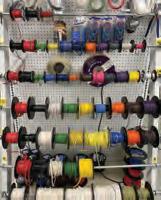


The surf can be bountiful and as easy as shing can be when the seas are calm. On a recent trip to the Gulf of Mexico’s calm shores, I was certain I was going to catch them at will. To the naked eye, conditions were as good as it gets, but many fellow anglers fell short of their dreams on this beautiful day. Here are some modi cations I made on the y that allowed me to come out ahead of most others.
is day provided us with glass-calm seas, clear water and bait everywhere, but one key ingredient was missing, substantial tide. What most of us focused on, including myself, were the calm conditions. is is always the draw for trout shing on the beachfront in Texas, and it is seldom the norm.



I did research the tide, and it was an early high

heading out, which, once again, seems perfect. However, the slope on the graph was a slow outgoing tide, not one that was going to trigger many bites on its own. Once I realized this and watched others leave empty handed, I decided to search for places that would encourage the slow outgoing current to increase in velocity. I sought out guts in the bars perpendicular to the shore. ese same guts have the potential to cause dangerous riptides, and they can also be the best place to sh. You typically see these guts by studying the waves, but with no waves I had to use my polarized glasses. ankfully, the water clarity made this an easy task. I drove along the beach looking for these, and once I spotted them, I stood on the back of my truck to increase my elevation to identify the best ones.
I’d found my pattern. Now the catching could begin! Keep in mind, as slow as the tide was moving, it did not create a dangerous situation


(always be cautious of rip tides on the beach), but it did speed up the current enough to trigger a good bite. I thoroughly worked all edges of these guts, nding most bites on the back side where the tide pulled bait from the shallow gut to the deeper second gut.

When the tide is slow, I like to try and get a reaction strike by throwing something a little di erent or working my lure erratically. On this day, I was throwing a rattling so -plastic paddletail. I also picked one with a bright green tail to stand out from the millions of bait sh traveling the rst and second guts. All of these tactics combined allowed me to salvage a day when most le with empty stringers.
e beachfront can be a great place to sh, and it’s fun for the kids. My boys enjoy wading beside me, and when the shing is over it’s time to play at the beach!






Alaska shing season started o with a bang for anglers visiting Ketchikan, Alaska. Halibut shing charters produced great catches of halibut, paci c cod, lingcod and rock sh. Salmon shing trips resulted in big king salmon while we awaited the arrival of silver salmon and pink salmon.

Early season typically is more inconsistent than the deep summer months of July, August and September. With that being said, our guests enjoyed better than average shing to start o the 2023 Alaska shing summer.








Fishing tours for cruise ship guests and y-in anglers spent the majority of May bottom shing. ese sheries consist of shing near and o shore waters for halibut, cod and rock sh. Deep-water jigging for halibut had guests reeling in keeper-sized halibut as well as oversized halibut ranging from 10 pounds to 120 pounds. ere’s nothing quite like the thrill of hooking into these deep sea dwellers, and the delicious white meat holds up well when frozen and shipped back home to the lower 48.
Halibut weren’t the only species caught during our halibut shing charters. Paci c cod were a staple while bottom shing for halibut. Cod were concentrated in large numbers on the sandy ats eating a variety of bottom rigs. Traditional halibut shing rigs with glow-in-the-dark squid and cut herring caught the majority of Paci c cod. We also found great success jigging for cod with metal jigs and so plastic swimbaits.
Following up halibut shing with rock sh and lingcod jigging made for a combination catch that had everyone smiling. We do this in shallower water with light tackle. While catching pelagic rock sh such as yellowtails and duskies, we also caught big lingcod. With such a phenomenal bottom shing area, you’re never quite sure what will grab the end of the line. Giant lingcod make a trophy catch for anyone visiting Alaskan waters.
King salmon shing opened June 1. Everyone rejoiced at the opportunity to pursue this iconic sh. Big king salmon catches came in throughout the entire southeast Alaska region. Ketchikan is known as the salmon capital of the world, and it didn’t disappoint. Herring Cove and Mountain Point were the rst areas to open up. is resulted in large numbers of anglers trolling for prized king salmon. As we look forward for the entirety of the region to open, these were the rst areas where big catches came in.
Over the next couple months, the shing will continue to heat up! Halibut will continue to show up in larger numbers as the water temperatures increase. In addition, the salmon shing will see a big burst of silver salmon and pink salmon to combine with the larger king salmon. It’s all happening now!
For more information, visit www.ketchikan shingtrips.com or call (907) 617-4717.
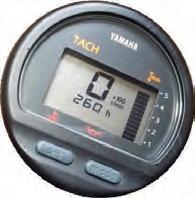
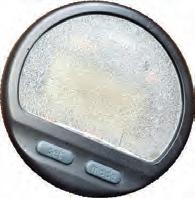




Most of the time the saying is true, bigger baits equal bigger sh! Although elephants eat peanuts, a big bait pro le is something big sh sometimes can’t resist whether you’re shing the open ocean or the Great Lakes. I’ve spent a lot of time in the last couple years experimenting with lures that are larger than what my previous comfort zone was for bass. It is pretty special to see what gets curious to come look at or bite these big baits.
ere are many di erent types of swimbaits on the market, but I’ll break them down into two styles to keep it simple. ere are hard, gliding-style swimbaits with treble hooks and there are so -body swimbaits. Each has a time and a place, and both attract some very big sh.
Depending on where you are in the country and the size of the forage in your lake, a normal meal for a bass is usually much bigger than you would think. Bass have huge mouths to accommodate large prey items. A two- or three-pounder has no problem at all swallowing a 6- to 8-inch bluegill whole. I’ve seen 10-plus-pounders eat gizzard shad up to 14 inches long! Trying to exactly duplicate the larger bait sh in your lake with a natural presentation is the key to drawing attention to your arti cial lure.
With hard swimbaits, my rst choice is a shad imitation. Most of the places I sh are full
of shad, and shad seem to be a favorite food source for bass.


Crappie are another forage species people sometimes forget about. Lately, when throwing big baits
over deeper water, I’ve caught some big sh with crappie down in their throats.
With so swimbaits, I usually go to a bluegill imitation. I like so baits because they are more weedless, and you can creep them through the grass or along the bottom in places where bluegills live.
Big swimbaits can get mighty expensive. If you are just getting started with them, I would suggest sticking with the more a ordable baits that get good reviews until you get your con dence up. en you can dive into some of the larger, more customized lures.
Learning to sh big baits is best done by getting on the water and doing it. Just get out there and experiment with retrieves until you nd out what works. Of course, throwing giant lures requires special equipment. I like 13 Fishing’s a ordable Defy for a rod. It’s an 8-foot swimbait rod that handles most big lures with ease. I pair this with a 300 sized reel, like the 13 Fishing Concept A3 and some 20- to 25-pound Seaguar Abrazx.
I hope this article sparks someone’s interest to get out there and throw a big bait. Once I stepped out of my comfort zone, I discovered it to be one of the coolest and most fun ways to target big bass all year long. Don’t hesitate to reach out to me on social media if you have questions about these tactics or any others.
Tyler Woolcott is a professional tournament angler and guide. Check out his website at www.tylerwoolcott shing.com.

really realized that I hooked a monster. Adrenaline started pumping hard and the fear of losing it almost sent me into a panic. I was alone, facing the biggest cat sh I ever seen in 23 years.
Italy’s River Po has done it again.
Last week, MADCAT pro sta er Alessandro Biancardi caught a 9-foot-long wels cat sh that will likely replace the IGFA world length record for the species. e monster wels measured 285 centimeters (9 feet, 4.2 inches) in length and stands to beat out the existing record by just 4 centimeters, or about an inch and a half.

Biancardi is a veteran cat sh angler who has targeted wels for more than two decades. He landed his potential new record a er a more than 40-minute battle while shing solo in an aluminum


jonboat.
e giant sh ate a so -plastic paddletail shed on a jighead.
“In silence, I approached the rst spot and a er few casts a powerful bite arrived. e sh stood still some seconds before starting a very complicated ght, between strong currents and a lot of submerged obstacles,” Biancardi wrote in a blog post. “I calmly managed to ght what I felt to be a prehistoric sh. I followed it for 40 endless minutes. When it surfaced for the rst time, I
“I tried gloving its mouth two or three times, but it was still too strong,” he wrote. “I decided to go in shallow water trying to land it from shore, and a er few tries, I managed to land it! I tied the sh to let him recover from the long ght then I suddenly realized that the boat was not anchored, and it was going away in the current. I was forced to have a swim to recover it with all my stu .”
Biancardi then called some friends from a nearby sh camp to come help him get a good measurement on the beast. A er taking measurements, the sh was released. Without a weight, it will not be considered for the all-tackle world record, which stands at 297 pounds, 9 ounces for a sh caught from the Po back in 2010.
For more, go to https://madcat- shing.com.


Coastal Angler and The Angler Magazine, Suzuki Marine and Sea Eagle have come together to offer readers a shot at this Sea Eagle FishSkiff 16 paired with a Suzuki DF4 outboard that’ll take you wherever the fish are. The FishSkiff 16 is an inflatable fishing boat that is lightweight, sturdy, stable and extremely packable. It rolls up small enough to fit in the trunk of a car and quickly inflates into a fishing machine. Powered by Suzuki’s four-stroke DF4A, you’ll have to hold on to your hat as you scream over the flats. Designed for efficiency and performance and portability, the DF4A provides all the speed and acceleration you can handle. It’s lightweight and can be attached or removed with ease.

Ifyou’re anything like my dad, you give your family everything. Your name, your time, your values — the people in your life know they can depend on you for practically anything. In exchange for imparting all of this energy and experience, you expect nothing in return.
e point? You deserve to treat yourself once in a while. You do so much for the people you care about. Now it’s time to focus on you for just a few minutes. at’s where the Men’s Due Volta Watch comes in. is astonishing innovation provides a digital readout that’s powered by a precise quartz engine, combining both analog and digital timekeeping.
Out tted with a stopwatch, alarm, a.m./p.m. settings, and day, date and month complications, this timepiece stands out from the crowd. With its large face and handsome, masculine design, this watch is perfect for the back nine and the happy hour afterwards. Water-resistant up to 3 ATM, this timepiece won’t wimp out if you have a run-in with a water hazard.
Other hybrid watches can sell for thousands of dollars, but because we’ve built more than 1 million watches, we know how to create real value. at’s why we can o er this timepiece for just $59! If you’re not completely satis ed with this watch, return it for a full refund.

Act quickly! is one-of-a-kind watch has been one of our fastest sellers this year. Of our original run of 2,872, we only have 389 left for this ad! In the last couple of years there’s been a watch shortage, but Stauer has got you covered. If you’re the kind of man who gives everything and expects nothing in return, it’s time to treat yourself.

Watch Speci cations:










•Complications: stopwatch, alarm, a.m./p.m. settings, and day, date and month



•Precision movement chronograph

•Stainless steel caseback and crown

•Water-resistant to 3 ATM
Men’s Due Volta Watch $399 $59* + S&P Save $320








 By Gary Turner
By Gary Turner
The sun was just cresting the mountains and the moon was low in the west as Capt. Ron Ratlief, of Ron’s Fishing Guide Service, and I began shing for redear sun sh on Arizona’s Lake Havasu. is trip has been on my bucket list for years. I just never made the time, which is ridiculous considering Havasu is pretty much the Holy Land for bream shing.
Havasu is a large Colorado River reservoir on the Arizona/Colorado border. In recent years, the lake has produced a series of world-record redear sun sh, with the current mark standing at 6-pounds, 4-ounces. Havasu’s freakishly large redears are due to a plentiful food source of invasive mussels that have in ltrated the system. e lake also holds some enormous bluegills, which I came to nd out over two days shing with Ron and a third day with my buddy Zac Mickle.
You could feel it was going to be a hot one—over 100 degrees— as the cool morning air evaporated with the sun. A er all, Havasu is an oasis in the middle of a desert. We started the morning sight shing coves. Havasu’s water is as clear as the Keys, and I half expected to see bone sh swimming by. We searched several coves and saw lots of sh, including bluegills, carp, cat sh, giant gizzard shad, tilapia, green sun sh and small stripers, just
to name a few. We also found some redear sun our target species, but they were small, a pound or less, and we were looking for big ones!
We moved to plan B and headed to deeper water. Havasu has the most man-made attractors and brushpiles I’ve ever seen. might be a bunch in South Carolina’s Santee, but you would never see them. e crystal-clear water makes everything visible, and as the sun got higher, we could see even more. We saw structure clearly in 18 feet of water with large redears on it. I dropped a night crawler on a jig head down, and BAM! I had a good bite! We landed a nice redear heavier than two pounds and continued hitting deeper brush, where we saw some big ones and caught a thick 14-incher that was pushing 3 pounds. A er several other sh in the 1 to 1 ½-pound range, Ron suggested we move back to a cove for a few last casts before heading in.
In the cove, I got hammered by a good one, which upon landing was about the same size as the 2-pounder from earlier, but it looked more like a bluegill. I was thinking it might be a hybrid between the two species, which was later con rmed.

If you like bream, you need to check out Havasu. It is a beautiful lake in the desert with some giant redears and bluegills. I might not have


caught a world record this year, but I’ve already booked next year’s trip.

Check out Gary Turner’s shing adventures on his YouTube channel at youtube.com/ @FishingWithGary.
















Travel the globe, without leaving home—with this set of the world’s ve most popular pure silver coins. Newly struck for 2023 in one ounce of ne silver, each coin will arrive in Brilliant Uncirculated (BU) condition. Your excursion includes stops in the United States, Canada, South Africa, China and Great Britain.
Each of these coins is recognized for its breathtaking beauty, and for its stability even in unstable times, since each coin is backed by its government for weight, purity and legal-tender value.

2023 American Silver Eagle: The Silver Eagle is the most popular coin in the world, with its iconic Adolph Weinman Walking Liberty obverse backed by Emily Damstra’s Eagle Landing reverse. Struck in 99.9% fine silver at the U.S. Mint.



2023 Canada Maple Leaf: A highly sought-after bullion coin since 1988, this 2023 issue includes the FIRST and likely only use of a transitional portrait, of the late Queen Elizabeth II. These are also expected to be the LAST Maple Leafs to bear Her Majesty’s effigy. Struck in high-purity



99.99% fine silver at the Royal Canadian Mint.
2023 South African Krugerrand: The Krugerrand continues to be the best-known, most respected numismatic coin brand in the world. 2023 is the Silver Krugerrand’s 6th year of issue. Struck in 99.9% fine silver at the South African Mint.



2023 China Silver Panda: 2023 is the 40th anniversary of the first silver Panda coin, issued in 1983. China Pandas are noted for their heart-warming one-year-only designs. Struck in 99.9% fine silver at the China Mint.


2023 British Silver Britannia: One of the Royal Mint’s flagship coins, this 2023 issue is the FIRST in the Silver Britannia series to carry the portrait of King Charles III, following the passing of Queen Elizabeth II. Struck in 99.9% fine silver.





These coins, with stunningly gorgeous finishes and detailed designs that speak to their country of origin, are sure to hold a treasured place in your collection. Plus, they provide you with a unique way to stock up on precious silver. Here’s a legacy you and your family will cherish. Act now!
You’ll save both time and money on this world coin set with FREE shipping and a BONUS presentation case, plus a new and informative Silver Passport!
2023 World Silver 5-Coin Set Regular Price $229 – $199 SAVE $30.00 (over 13%) + FREE SHIPPING






FREE SHIPPING: Standard domestic shipping. Not valid on previous purchases. For fastest service call today toll-free


1-888-201-7070






















Offer Code WRD333-05









Please mention this code when you call.






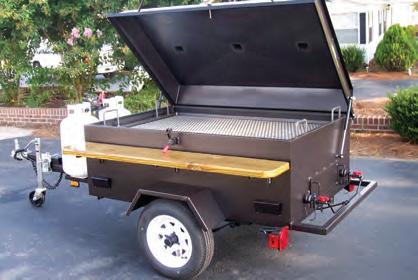
 By Capt. Judy Helmey
By Capt. Judy Helmey
Check out the crazy markings on this Pennsylvania bass!
Recently the American Fisheries Society Black Bass Conservation Committee (BBCC) posted photos of this striking, black-splotched largemouth bass on its Facebook page.

During the old days of chumming, lots of shermen used glitter in their chum, but we sure didn’t talk about it. Why? It was a serious sh-catching secret, and it works as well now as it ever did.
Of course, back then we hadn’t heard of microplastics. We didn’t equate those tiny ashy akes with pollution. Traditional glitter is made with aluminum and plastic, which is a really bad thing to be throwing in the water. ankfully, today there is biodegradable glitter made of plant cellulose. is more environmentally friendly product enables us to keep using our old tricks without doing harm to the ocean.
When you add biodegradable glitter to your chum, the oils coat
every single small piece of glitter. When it hits the water, each piece of glitter becomes sh attractant. As it slowly spreads through the water column, it catches sunlight and re ects it. e oil onboard each small piece of glitter leaves a trail that only a hungry smart sh would care to follow.
You might ask how do I know that glittering chum works? Well, when you start getting hits and landing sh, open the sh box and take a look. You know how glitter is. It gets everywhere and sticks to everything. Well, your sh box and the sh in it will be coated in glitter. Trust me.

Capt. Judy Helmey runs Miss Judy Charters o the Georgia coast. Check them out at missjudycharters.com.

e photos, by professional bass sherman Grae Buck, show his wife Jessica Buck holding a sh with melanosis. e post goes on to explain that this condition is when something a ects the pigment expression in the skin, turning it black. Termed blotchy bass syndrome, it has been found in black bass species in waterbodies across the United States with increasing frequency.
“While a truly melanistic sh would be all black, we more commonly see parts of the sh black, irregular blotches, spots, or ns,” the post reads. ese crazy colored sh show up from time to time, and previously it has been explained as a genetic mutation. In its explanation of this sh, however, BBCC pointed to research being conducted at the U.S.G.S. Eastern Ecological Science Center in West Virginia.
e research found that this blotchy skin condition is actually caused by a viral infection, an emerging novel adomavirus. Researchers have not pinned down a cause yet, but a U.S.G.S. report suggests higher incidences of blotchy bass syndrome in disturbed-water systems, with a potential link to chemicals. ere is currently broad ongoing research to try and determine the causes and e ects of this infection.


Follow the BBCC at www.facebook.com/AFS.Black.Bass.


Home of world class fishing on the beautiful Watauga Lake, rugged Doe River and designated trophy trout stream, Watauga River
